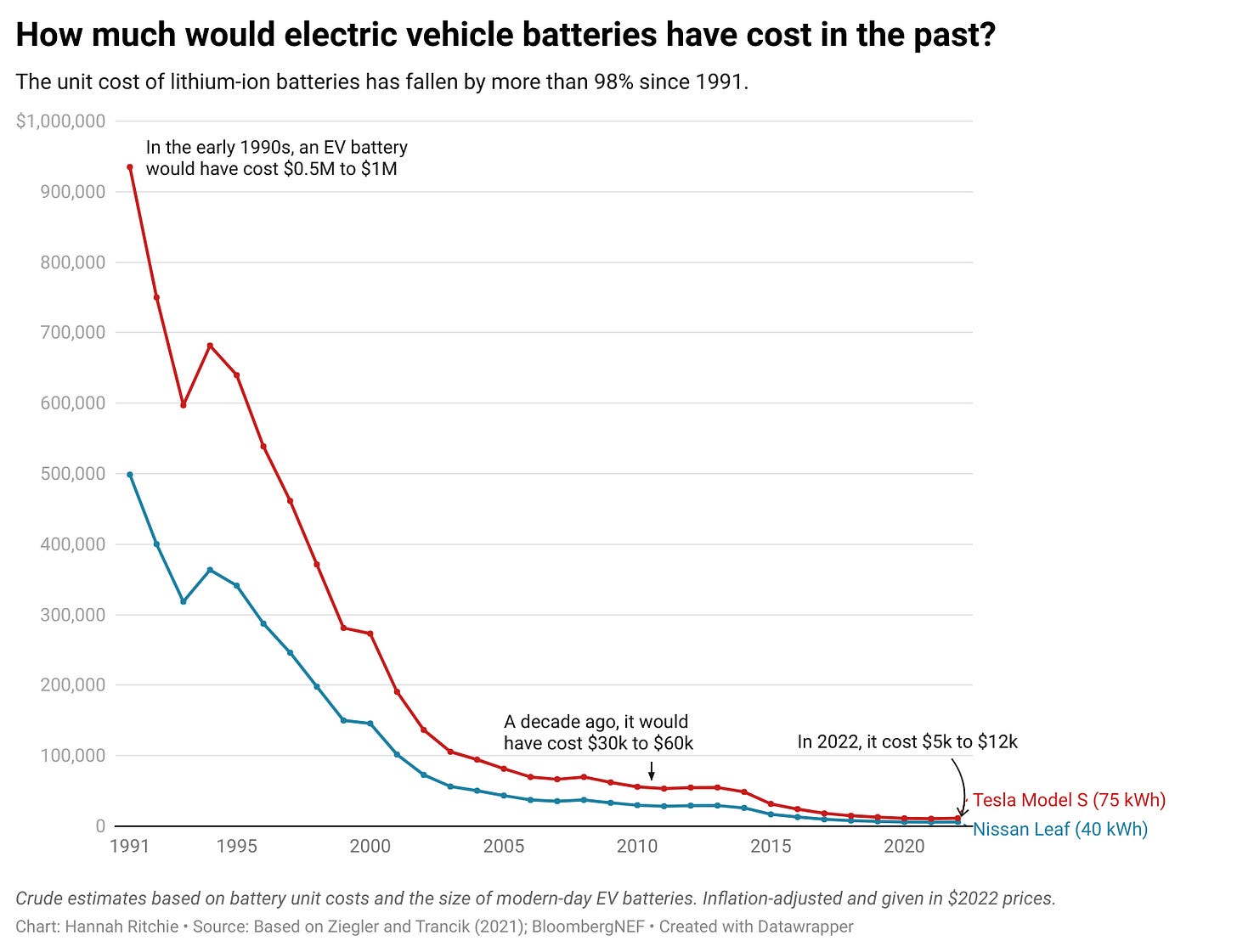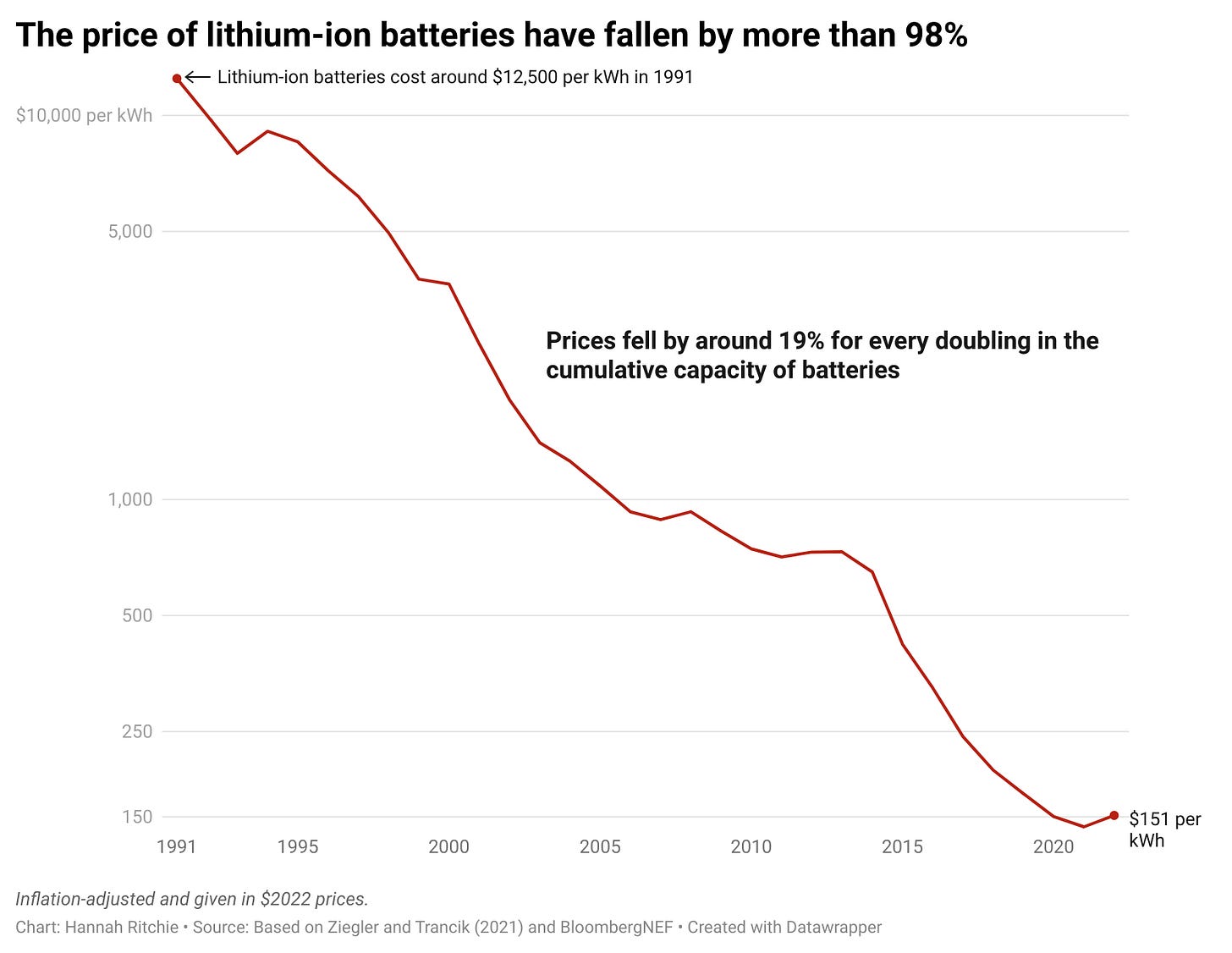Most of us underestimate how quickly electric vehicles (EVs) will take over the car market.
Sales data from the last few years gives us some clues. Almost 10% of cars sold in 2021 were electric. That might seem small, but consider how fast this is growing: the year before it was 4%, and just 2.5% in 2019.
In many countries, this percentage is much more: in Norway, almost 90% of cars sold in 2021 were electric; in the Netherlands, it was one-in-three, and in the UK and Portugal, one-in-five. It was 16% in China, tripling from 5% the year before.
That’s not all: the world has already passed the ‘peak’ of fossil car sales. And many countries have set a deadline to phase out petrol cars within the next decade.
This has happened incredibly quickly. EVs were on the fringe for a long time – a luxury for the rich, or the engineering nerds – but are now mainstream. Why?
It’s mostly down to the plummeting cost of batteries. They have only become cost-competitive in the last few years.
I wanted to see how much the cost of electric vehicles has changed over time. What would one have cost in the 1990s, or the early 2000s? It was impossible to find a chart or dataset of these estimates. First, battery costs are nearly always given per unit of battery capacity (such as kilowatt-hours). Even then, I struggled to find a long-run, updated series on battery prices. Second, I didn’t just want these numbers per unit: I wanted a sense of how much an actual car battery would cost.
So I reconstructed my own series and did some back-of-the-envelope calculations to estimate how much EV batteries would have cost from the 1990s onwards. My sources, methodology and assumptions are at the end of the article.
I’ve done this for two cars: the Tesla Model S (which has a 75 kWh battery), and the more affordable Nissan Leaf (with a 40 kWh battery).
I should stress that these are crude estimates: there was no Tesla car or Nissan Leaf in the 1990s. It’s just a fun thought experiment that gives us an important insight into how the landscape of electric cars has been transformed.
Battery costs have fallen by more than 98% since 1991
The battery in a Tesla Model S costs around $12,000 today. In the early 1990s, it would have cost just shy of a million dollars.
The battery in a Nissan Leaf is smaller and costs around $6,000 today. In the early 1990s, it would have cost almost half a million dollars.
I did some sense-checks to make sure my calculations were credible. My recent estimates are very close to the actual prices. In October 2022, the Tesla Model S battery cost $12,000 to $13,0000. The Nissan Leaf battery cost $5,500 in 2020.
You can see the decline in the estimated cost of these batteries in the chart. These prices are adjusted for inflation.1
In the last 30 years, the price has fallen by more than 98%.
EVs didn’t stand a chance of making it commercially until the last few years. Even a decade ago, the battery alone would have cost between $30,000 and $60,000. The total price of the car would have been even more than that.2

How did the price of batteries fall so quickly?
Why did the cost of batteries fall so quickly? Mostly the learning that comes from the deployment and scale-up of technologies.
We’ve worked out how to make lithium-ion batteries much more energy-dense – this means they get more electrical energy per liter (or unit) of battery. In 1991 you could only get 200 watt-hours (Wh) of capacity per liter of battery.3 You can now get over 700 Wh. That’s a 3.4-fold increase.
They’re not just cheaper, they’re much smaller and lighter too.
Batteries have followed what we call a ‘learning curve’, where the more you build, the cheaper they become. For every doubling in battery capacity, prices fell around 19%. This is very similar to the 20% learning rate of solar PV modules.
 The Top 10 EV Battery Manufacturers in 2022
The Top 10 EV Battery Manufacturers in 2022
These trends should make us optimistic about the energy transition
People are often pessimistic about climate action and the energy transition. It can feel like nothing is happening, and that the decades of campaigning, international agreements, and personal cuts have made little difference. The problem is one (or both) of the following:
-
They are looking at data that’s older than the last few years;
-
or, they’re looking at absolute numbers rather than growth rates.
If you’re looking at data on technological transitions from 2015, 2016, or even 2018, then you’re well behind the times. No wonder nothing was happening: these technologies would have emptied everyone’s pockets. To understand the potential of low-carbon technologies you need to look at the last few years. This is when they’ve been cost-competitive enough to get a space on the road.
And if you’re focusing on absolute numbers: how many of our existing cars are electric, or what the total capacity of batteries is, then you’ll be disappointed. But this tech has only had a few years of being competitive – of course it’s not going to dominate the market yet.
The transition to electric vehicles is here, and could happen extremely quickly. This is not only better for the climate (regardless of the electricity source), it’s better for local air pollution, and also provides a much better driving experience.
If this decline in cost continues, it will soon be much better for consumers’ wallets too.
Methodology
The basis of these estimates is simple: if we know the unit cost of batteries – how much they cost per kilowatt-hour – we can multiply this by the size of the battery in an electric vehicle to get the total cost.
Battery prices per kilowatt-hour
First, we need a long-run, standardised series of lithium-ion battery costs per kWh. This was impossible to find, so I had to combine sources and do some conversions to get it all in comparable $2022 prices.
Data from 1991 to 2012 comes from the work by Ziegler and Trancik (2021).4 I had to do two conversions to these figures:
-
They were initially given in $2018 prices. I converted them to $2022 using a conversion factor of 1.192.
-
They gave the cost of battery cells only. We need the total cost, which includes both the battery cell and pack. Looking at data from from BloombergNEF over the last decade, I calculated that the cells are around 72% of the total cost of the battery. So, I adjusted the “cell only” price for the entire series by dividing by 72% and multiplying by 100%.
This is one assumption that I’m uncertain about: I’m having to assume that 72% is a reasonable estimate for the ratio of cells-to-packs since the 1990s. in prices in the 1990s and early 2000s.
Data from 2013 to 2022 comes from BloombergNEF. This provides the combined price of cells and packs, and prices are given in $2022. So these figures were taken straight from the source.
This gave me a combined series of the unit cost of lithium-ion batteries from 1991 to 2022 in $2022. I’ve plotted it as a chart here. And here is the logarithmic version.

Calculating the cost of EV batteries
Now that we have the unit cost of batteries, we can multiply it by the size of EV batteries.
The Tesla Model S has a 75 kWh battery. The Nissan Leaf has a 40 kWh one.
To get the estimated total costs, we just multiply the battery unit cost series by 75 and 40 kWh for the Tesla and Nissan Leaf, respectively.
Hannah Ritchie















